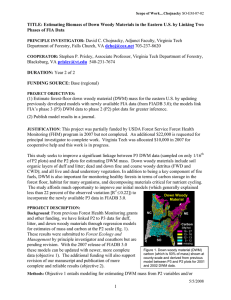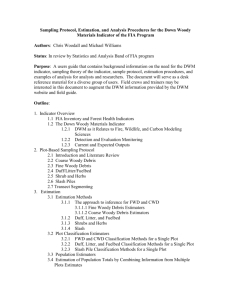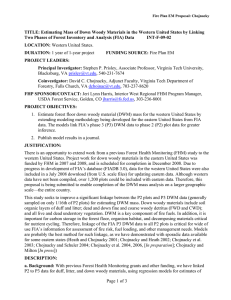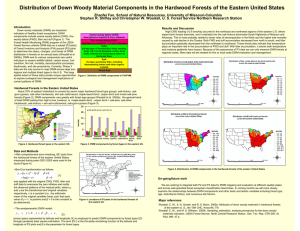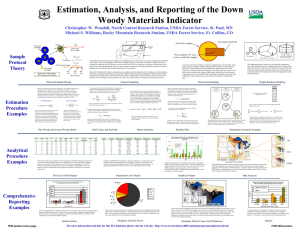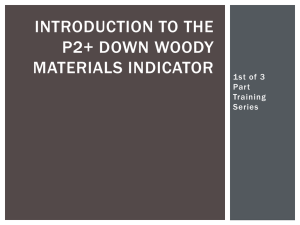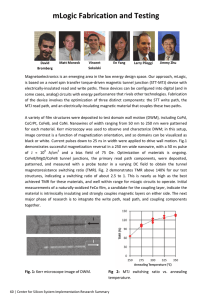Sensitivity Analysis of Down Woody Material Data Processing Routines
advertisement
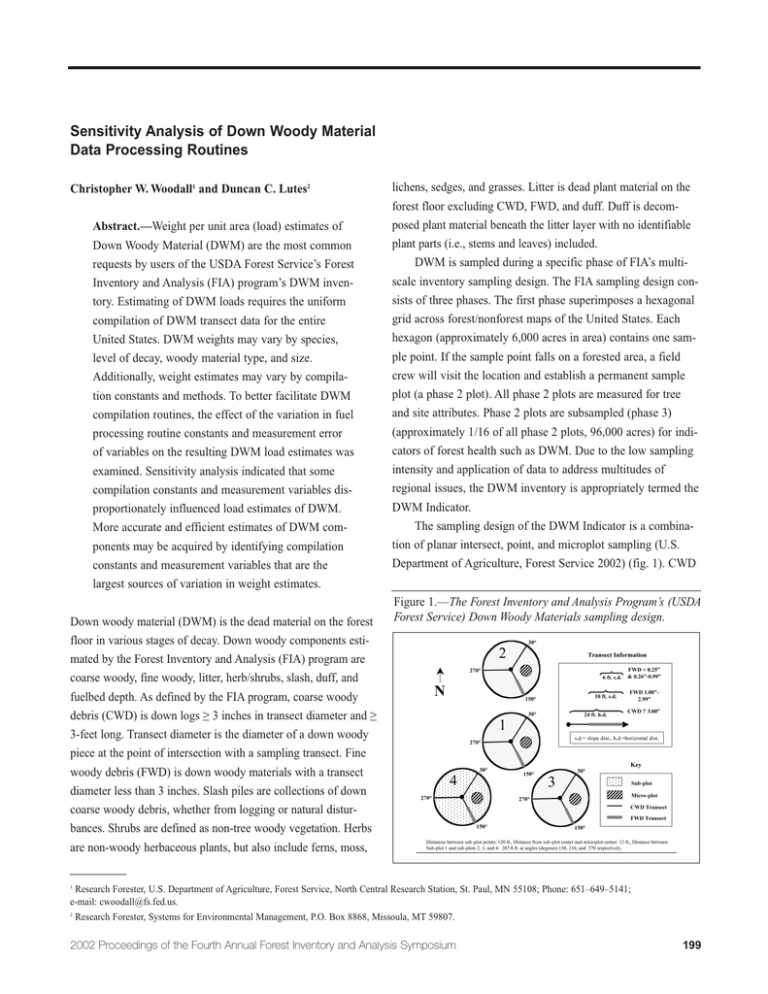
Sensitivity Analysis of Down Woody Material Data Processing Routines Christopher W. Woodall1 and Duncan C. Lutes2 Abstract.—Weight per unit area (load) estimates of Down Woody Material (DWM) are the most common requests by users of the USDA Forest Service’s Forest Inventory and Analysis (FIA) program’s DWM inventory. Estimating of DWM loads requires the uniform compilation of DWM transect data for the entire United States. DWM weights may vary by species, level of decay, woody material type, and size. Additionally, weight estimates may vary by compilation constants and methods. To better facilitate DWM compilation routines, the effect of the variation in fuel processing routine constants and measurement error of variables on the resulting DWM load estimates was examined. Sensitivity analysis indicated that some compilation constants and measurement variables disproportionately influenced load estimates of DWM. More accurate and efficient estimates of DWM components may be acquired by identifying compilation constants and measurement variables that are the largest sources of variation in weight estimates. Down woody material (DWM) is the dead material on the forest floor in various stages of decay. Down woody components estimated by the Forest Inventory and Analysis (FIA) program are coarse woody, fine woody, litter, herb/shrubs, slash, duff, and fuelbed depth. As defined by the FIA program, coarse woody debris (CWD) is down logs ≥ 3 inches in transect diameter and ≥ 3-feet long. Transect diameter is the diameter of a down woody piece at the point of intersection with a sampling transect. Fine woody debris (FWD) is down woody materials with a transect diameter less than 3 inches. Slash piles are collections of down coarse woody debris, whether from logging or natural disturbances. Shrubs are defined as non-tree woody vegetation. Herbs are non-woody herbaceous plants, but also include ferns, moss, lichens, sedges, and grasses. Litter is dead plant material on the forest floor excluding CWD, FWD, and duff. Duff is decomposed plant material beneath the litter layer with no identifiable plant parts (i.e., stems and leaves) included. DWM is sampled during a specific phase of FIA’s multiscale inventory sampling design. The FIA sampling design consists of three phases. The first phase superimposes a hexagonal grid across forest/nonforest maps of the United States. Each hexagon (approximately 6,000 acres in area) contains one sample point. If the sample point falls on a forested area, a field crew will visit the location and establish a permanent sample plot (a phase 2 plot). All phase 2 plots are measured for tree and site attributes. Phase 2 plots are subsampled (phase 3) (approximately 1/16 of all phase 2 plots, 96,000 acres) for indicators of forest health such as DWM. Due to the low sampling intensity and application of data to address multitudes of regional issues, the DWM inventory is appropriately termed the DWM Indicator. The sampling design of the DWM Indicator is a combination of planar intersect, point, and microplot sampling (U.S. Department of Agriculture, Forest Service 2002) (fig. 1). CWD Figure 1.—The Forest Inventory and Analysis Program’s (USDA Forest Service) Down Woody Materials sampling design. 1 Research Forester, U.S. Department of Agriculture, Forest Service, North Central Research Station, St. Paul, MN 55108; Phone: 651–649–5141; e-mail: cwoodall@fs.fed.us. 2 Research Forester, Systems for Environmental Management, P.O. Box 8868, Missoula, MT 59807. 2002 Proceedings of the Fourth Annual Forest Inventory and Analysis Symposium 199 and FWD are sampled on transects radiating from each FIA subplot center. Information collected for every CWD piece intersected on each of three, 24-foot transects on each FIA subplot is transect diameter, length, small-end diameter, large-end diameter, decay class, species, evidence of fire, and presence of cavities (fig. 1). FWD with a transect diameter of 0 to 0.99 inches (1-hr and 10-hr) is tallied on a 6-foot slope-distance transect (one transect per FIA subplot) (fig. 1). FWD with a transect diameter of 1.00 to 2.99 inches is tallied on a 10-foot slope-distance transect (one transect per FIA subplot) (fig. 1). The duff and litter are sampled using a point estimate of depth at a 24-foot slope-distance along each CWD transect (for a total of 12 sample points). The shrub and herb fuel complex is sampled on the phase 2 microplot (6.8-foot radius) (fig. 1). The percentage cover (10 percent classes) and total height of dead and live shrubs/herbs (including grasses) is estimated. Slash piles with centers that are within 24 feet of any subplot center are sampled, using methodology developed by Hardy (1996). The shape of each slash pile is classified into four slash pile shapes. Based on the pile shape classification, appropriate dimensions of the slash pile are measured along with an estimate of pile density. DWM inventory field data are organized into seven database tables reflecting the various components estimated by the DWM sampling design: CWD, FWD, microplot, transect information, plot information, duff/litter, and slash piles. Although invaluable to numerous research initiatives, the seven tables of DWM data need to be processed to produce plot estimates of DWM components. Just as basal area/acre estimates are determined for phase 2 plots, users of FIA data desire weight per unit area (load) estimates of DWM. The seven tables of DWM data may be processed in many ways to obtain per acre estimates of DWM components. For a more complete guide to FIA’s DWM sampling design, please refer to U.S. Department of Agriculture, Forest Service (2002) or field guides from any of the other regional FIA units. The goal of our study was to ascertain through sensitivity analysis the impact of variations in data processing techniques and measurement errors on the final load estimates of DWM components. Sensitivity analysis results were used both to identify critical parts of DWM data processing algorithms and to manage the quality analysis and control of the DWM inventory. 200 Processing Algorithms Brown (1974) originally summarized many of the sampling protocols adopted by the DWM Indicator. In addition to the sampling design, Brown (1974) provided numerous load-processing models for DWM components. Although numerous DWM data processing algorithms are possible, the basic models of Brown (1974) and slash pile models by Hardy (1996) were used in the sensitivity analysis. FWD data were processed using the following constants and measurement variables: unit’s conversion constant (convert sampling measurement units to tons/acre), number of tallied FWD pieces, quadratic mean diameter (QMD) of the appropriate FWD size class, specific gravity, non-horizontal angle correction factor (corrects for DWM pieces nonperpendicular to transect line), slope, and transect total length (Brown 1974). CWD data were processed using the following constants and measurement variables: unit’s conversion constant, sum squared CWD transect diameters, specific gravity, nonhorizontal angle correction, slope, and total transect length (Brown 1974). Litter and duff data were processed using mean depths, specific gravity, and a unit’s conversion constant (Brown 1974). Slash pile data were processed using pile volume based on pile shape equations (Hardy 1996), specific gravity, and slash packing ratio (amount of wood occupying volume defined by pile dimensions). Methods The DWM inventory data from its first year of implementation, 2001, were used in this study. Over 900 plots were used in the analysis from 32 States distributed across the U.S. The effect of the variation in DWM processing routine constants and the measurement error of variables on the resulting DWM load estimates was examined using sensitivity analysis. The effect of 5-, 10-, and 15-percent variation in various selected DWM measurement variables and processing constants was evaluated in terms of final load estimates. Constants used in the sensitivity analysis include CWD specific gravity, CWD decay rate, litter specific gravity, FWD QMD, duff specific gravity. Measurement variables used in sensitivity analysis 2002 Proceedings of the Fourth Annual Forest Inventory and Analysis Symposium include FWD 0-0.25 inch tally counts, litter depth, CWD transect lengths, FWD transect lengths, slash pile heights, slash pile packing ratio, CWD transect diameter, and duff depth. Sensitivity analysis of DWM processing constants indicated that variation in constant values had disproportionate effects on total load estimates (fig. 2). A 5 percent increase in the specific gravity of a plot’s CWD pieces resulted in approximately a 1 percent increase in the plot’s total DWM load estimate, whereas a 5 percent increase in the specific gravity of duff resulted in nearly a 2.5 percent increase in the plot’s DWM load estimate. Obvious from sensitivity analysis, constants such as the specific gravity of duff and the QMD of FWD may have the greatest effect on resulting determinations of plot DWM load estimates (fig. 2). Because duff usually has a far greater specific gravity than litter, variations in its estimate can greatly impact on the total plot DWM load estimate. When processing DWM inventory data, special attention should be given to selecting constants that influence total DWM loading estimates the most. Sensitivity analysis of DWM measurement variables essentially is a review of the effect of measurement error on total DWM plot load estimates. Our analysis showed a disproportionate effect of variation in certain measurements on resulting variation in plot estimates. FWD tally counts, litter depth, and CWD transect lengths had a minor impact on plot totals: a 15 percent increase in their values resulted in less than a 3 percent variation in DWM plot estimates (fig. 3). For variables such as slash packing ratio, CWD transect diameter, and duff depth, a 15 percent increase in their associated values resulted in a greater than 5 percent variation in DWM plot estimate (fig. 3). Since duff and CWD components typically contain substantial tonnage, variations in their processing routines and/or measurement errors may have the greatest effect on resultant plot DWM estimates. Obviously, these sensitivity analysis results would not necessarily apply to individual DWM components such as FWD. Sensitivity analysis results indicate that the selection of any DWM processing routine may initially hinge on which DWM components contribute the most to overall DWM plot estimates. Since constants used to determine CWD and duff tonnage estimates might greatly affect output, those processing routines should be scrutinized first. For instance, DWM analysts should concentrate more effort on which duff specific gravity is selected for a plot than on what CWD specific gravity is selected for a certain CWD piece on a plot. Results from the sensitivity analysis of DWM variables (i.e., analysis of measurement error) have implications for DWM data quality assessment/quality control (QA/QC). Currently the QA/QC tolerance for measurement of duff depth is ± 0.5 inches. For the 2001 field season a 0.5-inch variation in duff depth would on average be a 20 percent measurement error. Based on this study’s sensitivity analysis, 20 percent measurement error in duff depth would result in a 9 percent error in plot DWM esti- Figure 2.—Effect of 5, 10, 15% variation in various down woody material processing constants on total per acre tonnage estimates. Figure 3.—Effect of 5, 10, 15% variation in down woody material measurement variables on total per acre tonnage estimates. Results/Discussion 2002 Proceedings of the Fourth Annual Forest Inventory and Analysis Symposium 201 mates of total load. The QA/QC tolerance of FWD 0-0.25-inchclass tally counts is ± 20 percent. Based on sensitivity analysis, a 20 percent measurement error of this FWD component will typically result in a 0.5 percent error in plot level estimates of total load. If users of FIA data are more interested in plot estimates of DWM components, QA/QC efforts might be better derived from a “top down” approach where plot estimate variation drives measurement error tolerances. If FIA customers desire total tonnage/acre estimates, reductions in measurement errors that greatly affect those load estimates should be undertaken rather than arbitrarily setting measurement error tolerances. gravity, CWD diameters, and slash pile dimensions) had disproportionately greater effect on total plot load estimates than other variables (CWD decay rates/classes/transect lengths, litter depth/specific gravity, and FWD counts), which had a minimal effect. The processing and QA/QC of the DWM Indicator may be further refined with a better understanding of data outputs desired by FIA constituencies, more holistic comprehension of how all DWM components interact during data processing, and QA/QC guidelines determined by analysis of actual field data. Literature Cited Conclusions The DWM Indicator of the FIA program provides the first nationally consistent inventory of DWM components. The DWM data sets quantify a structurally diverse component of forest ecosystems. Although FIA data are invaluable as a research database in its “unprocessed” form, numerous users desire plot estimates of DWM. These estimates fulfill data requirements of numerous forest research initiatives ranging from the fire sciences to carbon budget accounting. There are many methods for processing DWM data and many sources of measurement error. The sensitivity results of this study may help refine the debate among those that process DWM data and those that manage the quality of the DWM data. Some processing constants and measurement variables (duff depths, specific 202 Brown, J.K. 1974. Handbook for inventorying downed woody material. Gen. Tech. Rep. INT-16. Ogden, UT: U.S. Department of Agriculture, Forest Service, Intermountain Research Station. Hardy, C.C. 1996. Guidelines for estimating volume, biomass, and smoke production for piled slash. Gen. Tech. Rep. PNW364. Portland, OR: U.S. Department of Agriculture, Forest Service, Pacific Northwest Research Station. U.S. Department of Agriculture, Forest Service. 2002. Forest inventory and analysis national core field guide; volume II: field data collection procedures for phase 3 plots, version 1.6, section 14: 265–298. 2002 Proceedings of the Fourth Annual Forest Inventory and Analysis Symposium
